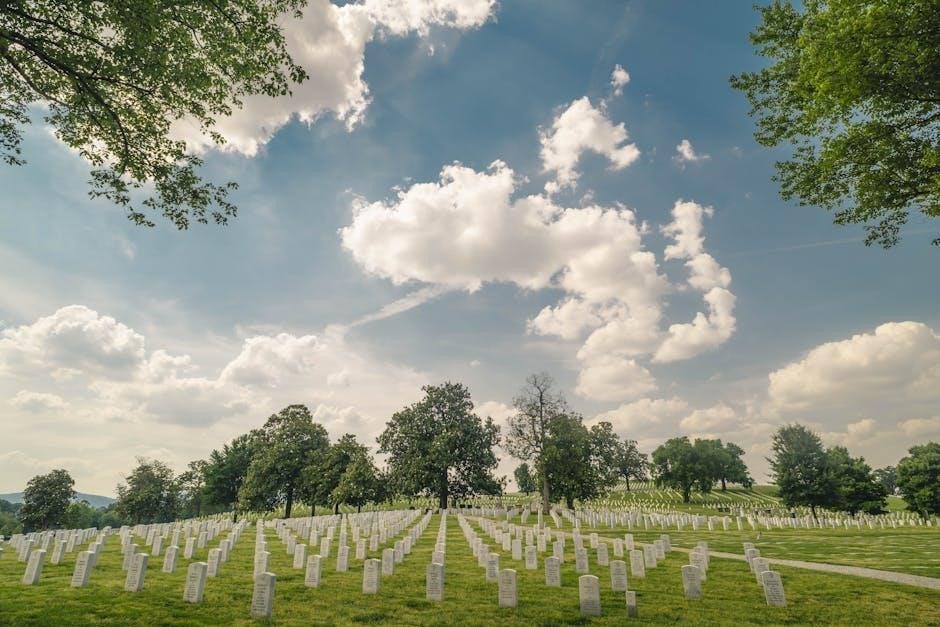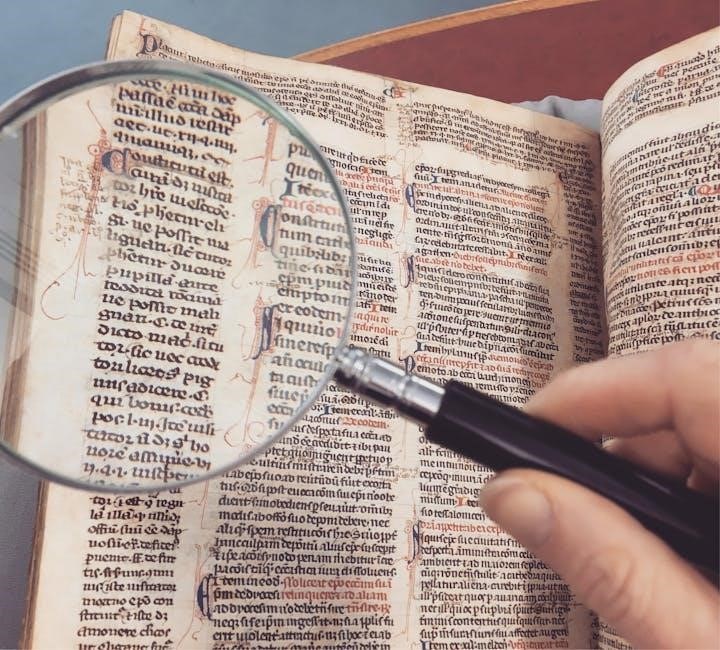US History Final Exam Study Guide
Ace your US History final with effective preparation! Consistency is key: Regularly review notes, timelines, and flashcards in short, frequent sessions. Use active recall by quizzing yourself without looking at your materials to boost memory retention for the exam.
Effective Study Strategies
To conquer your US History final, implement effective study strategies. Start by creating a structured study schedule, dedicating specific time slots for different topics. Consistency is key; short, frequent study sessions are more effective than last-minute cramming. Actively engage with the material by summarizing chapters, creating timelines, and teaching concepts to others.
Utilize flashcards for memorizing key dates, names, and events. Incorporate active recall by quizzing yourself without referring to notes, strengthening memory retention. Review past quizzes and assignments to identify areas needing improvement. Explore online resources like CliffsNotes and study guides for additional support and clarification.
Don’t just passively read; actively analyze the material by connecting events, identifying cause-and-effect relationships, and formulating your own interpretations. Participate in study groups to discuss challenging topics and gain diverse perspectives. Prioritize sleep and maintain a healthy lifestyle to optimize cognitive function. Start studying well in advance to avoid feeling overwhelmed and ensure thorough preparation for the exam.

Key Areas of Focus
Prioritize key historical periods, significant events, and key figures. Focus on understanding the nuance, evidence, and argumentation within each. Use provided AP US History notes and start studying at least one or two months before.
Important Historical Periods
To effectively prepare for your US History final, concentrate on crucial historical periods. Begin with the Colonial Era, understanding the foundations of American society, including early settlements, governance, and the burgeoning tensions with Great Britain. Next, delve into the Revolutionary Period, focusing on the causes, key events, and the establishment of the United States.
The Early Republic demands attention, covering the formation of political parties, economic development, and foreign policy challenges. Subsequently, dedicate time to the Civil War and Reconstruction, analyzing the causes of the war, its major battles, and the complex process of rebuilding the nation.
The late 19th and early 20th centuries are vital, encompassing industrialization, immigration, and progressivism. Finally, thoroughly review the Cold War era, emphasizing its origins, key events, and its impact on American society and foreign policy.
Significant Events
When studying for your US History final, focus on significant events that shaped the nation. Begin with the American Revolution, understanding its causes, key battles like Saratoga and Yorktown, and the impact of the Declaration of Independence. The Constitutional Convention is crucial, as it established the framework for American government.
Next, examine the Louisiana Purchase, which doubled the size of the United States and opened new opportunities. The Civil War requires in-depth study, covering events such as the attack on Fort Sumter, the Emancipation Proclamation, and battles like Gettysburg. Reconstruction’s successes and failures are also important.
The two World Wars are essential, involving America’s entry, major campaigns, and lasting effects. The Civil Rights Movement, with events like the Montgomery Bus Boycott and the March on Washington, transformed American society. Finally, study the Cold War, including the Cuban Missile Crisis and the Vietnam War, to grasp its global impact.
Key Figures in US History
To succeed on your US History final, thoroughly study key figures. Start with George Washington, understanding his role as commander during the Revolution and his presidency, which set precedents for the nation. Thomas Jefferson’s authorship of the Declaration of Independence and his vision for an agrarian republic are vital.
Abraham Lincoln’s leadership during the Civil War and his commitment to preserving the Union and ending slavery are essential. Frederick Douglass, an abolitionist and orator, offers insight into the anti-slavery movement. Franklin D. Roosevelt’s response to the Great Depression and leadership during World War II shaped modern America.
Martin Luther King Jr.’s leadership in the Civil Rights Movement is crucial, focusing on his advocacy for nonviolent resistance. Understand Ronald Reagan’s conservative policies and his role in the end of the Cold War. Studying these figures will provide a deeper understanding of pivotal moments and movements in US History.

Study Resources
Maximize your US History exam prep by utilizing textbooks, notes, and flashcards. Explore online resources, including study guides and course recordings, to deepen understanding and master key concepts for success.
Textbooks and Notes Review
Begin your final exam preparation by thoroughly revisiting your US History textbook and class notes. Chapter titles, section headings, pictures, maps, charts, and graphs are crucial resources. Actively reread key passages, focusing on nuanced interpretations and effective use of evidence presented throughout the course.
Pay close attention to arguments developed in your notes, ensuring a sophisticated understanding of historical events and their significance. Review any provided AP US History notes and resources to get up to speed.
Engage with review questions at the end of each chapter to solidify your comprehension and identify areas needing further attention. This comprehensive approach will provide a solid foundation for mastering the material and excelling on your final exam. Remember to connect historical events.
Consider drawing a blank timeline to fill in major events without consulting notes. Then, compare your timeline to the original, identifying gaps in your knowledge. This active recall technique is vital.
Flashcards for Memorization
Master US History facts with targeted flashcards! History is full of dates, names, and places that can overwhelm you. Flashcards are an excellent tool to remember a lot of information quickly and efficiently. Focus on key terms, significant events, and important figures. Create flashcards covering these essential elements to aid memorization.
Use mnemonic devices alongside flashcards to add a little silliness to studying, enhancing memory retention. Prioritize topics with the most weight in exams. For history, creating a timeline and noting down all events during specific time periods is highly effective.
Cram.com offers a platform to quickly memorize terms and phrases, helping you achieve the grade you want. Incorporate flashcards into your regular review sessions for consistent reinforcement. Regularly quiz yourself using the flashcards to actively recall information. Remember to study consistently.
This method ensures information sticks in your long-term memory, essential for excelling on your US History final exam. Consider using flashcards to remember the states in the Confederacy and Union.
Online Resources and Study Guides
Enhance your US History final exam preparation with online resources! CliffsNotes study guides are written by real teachers and professors, and are designed to ease homework headaches and help you score high on exams. Utilize online AP US History notes and resources to get yourself up to speed, ensuring comprehensive coverage of the material.
Dive into millions of student-shared lecture notes, summaries, and study guides from thousands of courses. Explore comprehensive study guides covering key topics for thorough understanding and excel in your studies today. Look for online resources that provide practice quizzes to test your knowledge and identify areas needing improvement.
Use online tools to create blank timelines, fill in major events, and check your accuracy against original timelines. Explore course recordings that focus on nuance, evidence, and argumentation to master the free-response section of the APUSH exam.
Leverage online flashcard platforms like Cram.com to memorize terms and phrases quickly. Maximize your score on test day by reviewing last-minute APUSH exam study tips and following a structured study schedule.

Exam Preparation Tips
Tackling the AP US History exam is a tough undertaking. There is a ton of information to be learned, many skills to master, and not a lot of time to do it all. But you absolutely can do it!
Time Management Strategies
Effective time management is crucial for US History exam success. Begin by creating a detailed study schedule, allocating specific time slots for each historical period or topic. Prioritize areas where you feel less confident, dedicating more time to those subjects. Break down large topics into smaller, manageable chunks to avoid feeling overwhelmed and to maintain focus.
During the exam, allocate your time wisely. Quickly scan the entire exam to assess the types of questions and their point values. Dedicate the most time to essay questions or sections with the highest weightage. Practice answering questions within the allotted time during your study sessions to build speed and accuracy.
If you get stuck on a question, don’t dwell on it for too long. Move on and return to it later if time permits. A strategic approach to time management can significantly improve your overall performance and reduce exam-related stress.
Active Recall Techniques
Active recall is a powerful study method for enhancing memory and comprehension in US History. Instead of passively rereading notes, actively try to retrieve information from your memory; One effective technique is self-testing. Create your own practice questions or use existing quizzes to challenge your knowledge. Answer the questions without referring to your notes, then check your answers to identify areas needing further review.
Another active recall method is the Feynman Technique. Choose a historical concept and explain it in simple terms, as if you were teaching it to someone else. Identify gaps in your understanding and revisit your study materials to fill those gaps. Flashcards are also useful for active recall. Write a question or term on one side and the answer or definition on the other, and test yourself regularly.
By actively retrieving information, you reinforce neural pathways and improve long-term retention, leading to better exam performance.

Post-Exam Review
The learning process doesn’t end when the exam is over. A post-exam review is crucial for solidifying your understanding of US History and identifying areas for future improvement. Begin by carefully reviewing the exam questions and your answers. Pay close attention to questions you answered incorrectly or struggled with. Consult your notes, textbook, and other resources to understand the correct answers and the reasoning behind them.
Analyze the types of questions you found most challenging. Were they related to specific historical periods, events, or figures? Did they require you to analyze primary sources or synthesize information from multiple sources? Identifying your weaknesses can help you focus your studies in the future. Reflect on your study strategies and time management during the exam. Did you allocate your time effectively? Did you use active recall techniques to retrieve information quickly?
Use this information to refine your study habits and improve your performance on future assessments.




Be the first to reply